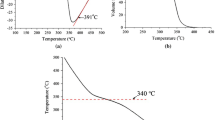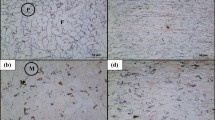Abstract
The mechanical properties of ultrafine lath-shaped low-carbon steel plates were studied. Results indicated that the hardness and tensile strength of the conventional low-carbon steel are HRC 19 and 410 MPa, respectively. With the decreased grain size of the ultrafine lath-shaped steel plates, the hardness and tensile strength of the test samples rapidly increase. Mechanical properties are at their optimum when grain size reaches 90 nm. Furthermore, both the hardness and the tensile strength values reach their maximum, which are HRC 53.5 and 1217 MPa, respectively.
Similar content being viewed by others
Avoid common mistakes on your manuscript.
Introduction
Though low-carbon steel has excellent plasticity and ductility features, it is characterized by poor strength and hardness. One of the effective methods for enhancing its properties is grain refining. Ultrafine-grained steel is produced through various technologies, such as equal channel angular pressing (ECAP) (Ref 1), multidirectional forging (Ref 2), and severe cold rolling of martensite (Ref 3, 4). These technologies generate ultrafine-grained steel with micron, submicron, or nanometer scale grains. Okayasu et al. (Ref 1) employed ECAP in producing dual-phase ultrafine-grained steel with an average grain size of 2.5 μm. Meanwhile, Salishchev et al. (Ref 2) used multidirectional forging technology to refine Cr25 ferrite steel, wherein the original grain size was reduced from 50 μm to 200 nm. Obtained by various technologies, ultrafine equiaxed grains have excellent mechanical properties.
At present, all ultrafine-grained low-carbon steel contains equiaxed grains; however, research on lath grains is rare. Tsuji et al. (Ref 3) obtained low-carbon lath martensite by water-quenching. It was annealed after cold rolling to obtain low-carbon steel plates of ultrafine equiaxed grains. Water-quenching easily leads to cracking of the quenched parts and inadequate hardness (Ref 5). In this article, brine-quenching method is adopted to obtain low-carbon lath martensite. In addition, ultrafine-laminated low-carbon steel plates are prepared, and their mechanical properties are studied.
Experimental Procedures
Low-carbon steel was smelted in a 2G-0.025 25 kg vacuum induction furnace and cast into steel ingots. The diameters of the steel ingot were 120 mm (upper) and 110 mm (lower), with height of 220 mm. Steel composition was determined using Advant′XP-381 x-ray fluorescence analyzer and CS-8800 infrared carbon-sulfur spectrometer. Table 1 demonstrates the chemical composition.
The test sample A0 was conventional low-carbon steel. The steel ingot was heated and maintained at 950 °C for 6 h and forged into 500 × 150 × 10 mm steel plates. Subsequently, the forged steel plates were air-cooled and heated again at 950 °C. The steel plates were ice brine-quenched after being soaked for 1 h and consistently rolled in the same direction on the forge rolling machine. The diameter of the roller was 400 mm, with a linear velocity of 0.25 m/s. The reduction ratios were 30, 50, and 80%. The rolled steel plates were annealed at 150 °C for 1 h. Tensile samples A1, A2, and A3 with different thicknesses were gathered using wire-electrode cutting method. The long axis of the tensile samples was parallel to the rolling direction. Seven detection points were selected from each of samples A0-A3 to measure hardness. The arithmetic mean value of the results indicates the hardness of the samples. Tensile strength of the sample was measured along its rolling direction, and microstructures of samples A1-A3 were observed using a JEM-2010 transmission electron microscope (TEM).
Results and Discussion
Figure 1 shows the microstructural morphologies of the test samples. As indicated in Fig. 1(a), the structure of the original samples is composed of ferrite (white) with a small amount of pearlite (dark), with an average size of 10 μm. The structure of the lath-shaped test samples is significantly refined, indicating that many fine and long lath colonies are formed in the A1 sample. The lath colonies of the A2 sample were nearly arranged in a parallel form. Moreover, they were narrow and branched out. Structure of the A3 sample was significantly refined.
Figure 2 illustrates the TEM images of the three test samples. The images show the specimen that consists of lath martensitic grains and weak bonding interfaces. The weak interfaces were formed in situ in the matrix upon cold-rolling and were parallel to the rolling plane and the rolling direction. The lath grains became parallel to each other and to the rolling direction with increasing cold reduction, implying the apparently delaminated structure of the steel. Figure 2(a) shows that the microstructure of A1 is the lath martensite grain, and there are many which consist of dislocations with high density in the lath. Additionally, the orientations of the dislocations are inconsistent. On the sample A1 through A3, it is found that the lath grains tend to be parallel to each other gradually, and the average width for the lath colonies gradually becomes smaller. Figure 2(c) shows that most of the lath grains of A3 sample are parallel. Average width of the lath martensite grain of the A1, A2, and A3 samples are approximately 600, 250, and 90 nm, respectively.
Figure 3 shows the hardness and tensile strength of all the test samples. Hardness of A0 is HRC 19, with tensile strength of 410 MPa. Both hardness and tensile strength of the samples rapidly increased with the decrease in grain size from A1 to A3. In addition, the sample grain has no evident anisotropy along the rolling direction and the transverse rolling direction because it is pie-shaped. When the grain size reached the nanometer scale, the Rockwell hardness number and tensile strength of the samples reached 53.5 and 1,217 MPa, respectively. These are six and three times greater than the performance of conventional low-carbon steel samples. Elongation of the sample is 5.53%. Its plasticity decreased compared with that of the conventional low-carbon steel materials.
Low-carbon lath martensite was obtained by brine-quenching. As the dislocation density increased, the strength of the sample improved. The distinct refining of multipass-rolled grains significantly improved the strength of the test samples. Figures 1 and 2 demonstrate that the structures of the test samples are distinctly refined; the structure of the A3 sample even reaches nanometer scale. The Hall-Petch equation indicates that the smaller the grain size is, the higher its strength will be (Ref 6-8). In addition, numerous studies indicate that materials of laminated structure present a laminated toughening effect (Ref 9, 10). A number of weak interfaces exist in the steel, which lead to the generation of laminated cracks as the interfaces encounter the propagating cracks in the tensile process. This delamination can also make the paths of the crack propagation very zigzag. The main fracture can be formed only after multiple cracking-propagation-deviation processes. Therefore, lamination is important for hardening effect and serves as a key factor in the achievement of high tensile strength for the high-deformation samples.
Increase in hardness is directly related to grain refining, wherein the decrease in grain size normally leads to a considerable increase in hardness. Therefore, when grain size of sample A3 reaches the nanometer scale, the Rockwell hardness increases to the value 53.5.
The steel with ultrafine grains and laminated microstructures is considerably improved in mechanical properties when compared with conventional low-carbon steel. Table 2 indicates the tensile strength of ultrafine-grained low-carbon steel reported by other authors. This table shows that the tensile strength of the ultrafine lath-grained samples reached the scale of the other ultrafine-grained steel. However, the strength of the steel with nanometer lath grains is higher than that of the other samples.
Conclusions
Ultrafine lath low-carbon steel samples possess excellent mechanical properties. The tensile strength and hardness of the samples rapidly increase due to the decrease in lath grain size. When the grain size reaches the nanometer scale, the samples reach hardness number of HRC 53.5 and tensile strength of 1217 MPa.
References
M. Okayasu, K. Sato, M. Mizuno, D.Y. Hwang, and D.H. Shin, Fatigue Properties of Ultra-Fine Grained Dual Phase Ferrite/Martensite Low Carbon Steel, Int. J. Fatigue, 2008, 30(8), p 1358–1365
G. Salishchev, R. Zaripova, R. Galeev, and O. Valiakhmetov, Nanocrystalline Structure Formation During Severe Plastic Deformation in Metals and Their Deformation Behaviour, Nanostruct. Mater., 1995, 6(5–8), p 913–916
N. Tsuji, R. Ueji, Y. Minamino, and Y. Saito, A New and Simple Process to Obtain Nano-Structured Bulk Low-Carbon Steel with Superior Mechanical Property, Scripta Mater., 2002, 46(4), p 305–310
N. Tsuji, Y. Saito, H. Utsunomiya, and S. Tanigawa, Ultra-fine Grained Bulk Steel Produced by Accumulative Roll-Bonding (ARB) Process, Scripta Mater., 1999, 40(7), p 795–800
C.Y. Yu and L. Liu, Quenching Cooling and Quenching media, Liaoning Science and Technology Press, Shenyang, 2010 (in Chinese)
J.R. Tarpani, W.W. Bose Filho, and D. Spinelli, Grain size Effects in the Quasi-Static Fracture Resistance of a Thermally Embrittled RPV Steel (Annealed Microstructures), J. Mater. Eng. Perform., 2002, 11(4), p 414–421
A. Shafiei Mohammadabadi and K. Dehghani, A New Model for Inverse Hall-Petch Relation of Nanocrystalline Materials, J. Mater. Eng. Perform., 2008, 17(5), p 662–666
J.E. Schaffer, Structure-Property Relationships in Conventional and Nanocrystalline NiTi Intermetallic Alloy Wire, J. Mater. Eng. Perform., 2009, 18(5), p 582–587
K.T.V. Rao and R.O. Ritchie, Mechanical Properties of Al–Li Alloys. I. Fracture Toughness and Microstructure, Mater. Sci. Technol. Lond, 1989, 5(9), p 882–895
J. Cui, Y. Fu, N. Li, J. Sun, J. He, and Y. Dai, Study on Fatigue Crack Propagation and Extrinsic Toughening of an Al–Li Alloy, Mater. Sci. Eng. A, 2000, 281(1), p 126–131
H. Azizi-Alizamini, M. Militzer, and W.J. Poole, A Novel Technique for Developing Bimodal Grain Size Distributions in Low Carbon Steels, Scripta Mater., 2007, 57(12), p 1065–1068
T.S. Wang, Z. Li, B. Zhang, X.J. Zhang, J.M. Deng, and F.C. Zhang, High Tensile Ductility and High Strength in Ultrafine-Grained Low-Carbon Steel, Mater. Sci. Eng. A, 2010, 527, p 2798–2801
T. Akita, M. Gotoh, S.V. Dobatkin, K. Kitagawa, and Y. Hirose, Influence of Annealing on Strength of Ultrafine Grained Low Carbon Steels by ECAP, Mater. Sci. Forum, 2010, 638–642, p 1899–1904
X.C. Li, X.T. Feng, S.G. Cai, and W. Chen, Study of Mechanical Properties and Forming Properties of Ultra-fine Grain Ferrite Steels, J. Plast. Eng., 2009, 16(1), p 162–166
Acknowledgment
The authors acknowledge the financial support from the National Natural Science Foundation of China (No. 50371073).
Author information
Authors and Affiliations
Corresponding author
Rights and permissions
About this article
Cite this article
Li, X., Jing, T., Lu, M. et al. Microstructure and Mechanical Properties of Ultrafine Lath-Shaped Low Carbon Steel. J. of Materi Eng and Perform 21, 1496–1499 (2012). https://doi.org/10.1007/s11665-011-0055-5
Received:
Revised:
Published:
Issue Date:
DOI: https://doi.org/10.1007/s11665-011-0055-5







